2000 HONDA PASSPORT height
[x] Cancel search: heightPage 17 of 267
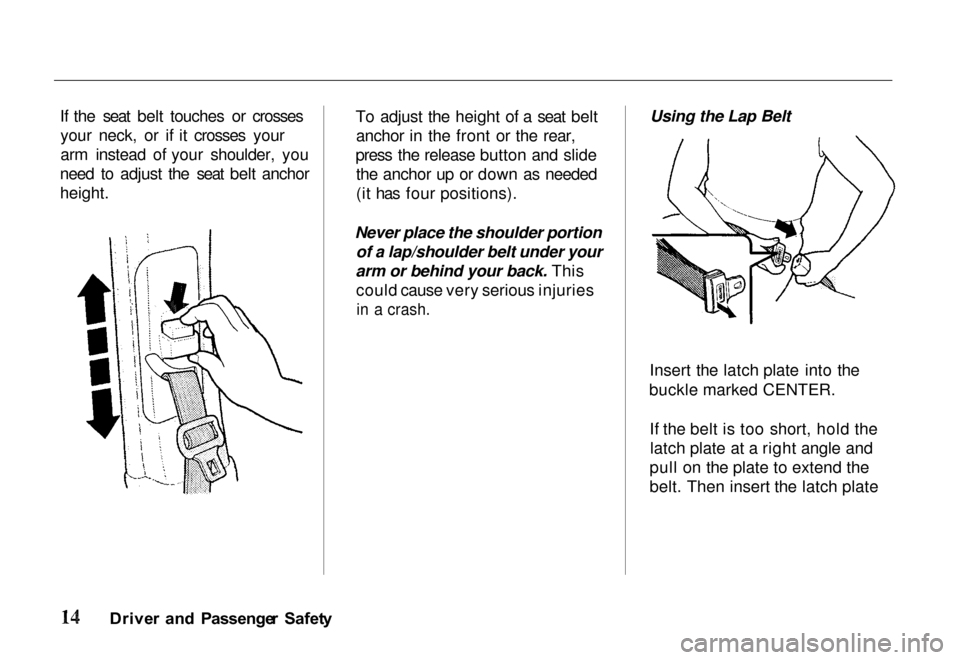
If the seat belt touches or crosses
your neck, or if it crosses your
arm instead of your shoulder, you
need to adjust the seat belt anchor
height. To adjust the height of a seat belt
anchor in the front or the rear,
press the release button and slide the anchor up or down as needed
(it has four positions).
Never place the shoulder portion of a lap/shoulder belt under your
arm or behind your back. This could cause very serious injuries
in a crash.
Using the Lap Belt
Insert the latch plate into the
buckle marked CENTER.
If the belt is too short, hold thelatch plate at a right angle and
pull on the plate to extend the
belt. Then insert the latch plate
Drive r an d Passenge r Safet y
Page 28 of 267
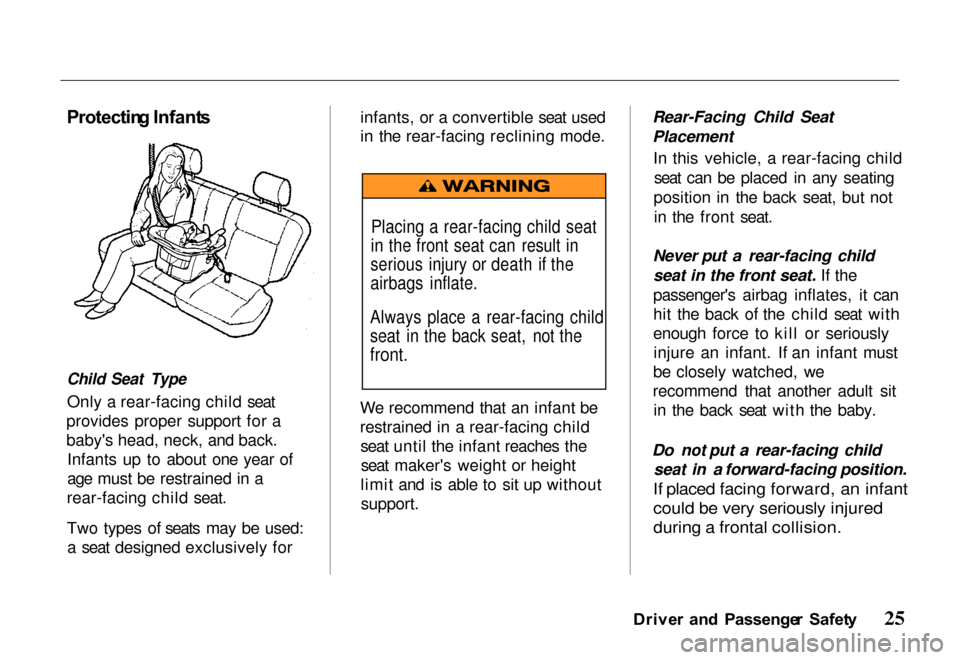
Protectin
g Infant s
Child Seat Type
Only a rear-facing child seat
provides proper support for a
baby's head, neck, and back. Infants up to about one year of
age must be restrained in a
rear-facing child seat.
Two types of seats may be used: a seat designed exclusively for infants, or a convertible seat used
in the rear-facing reclining mode.
We recommend that an infant be
restrained in a rear-facing child seat until the infant reaches theseat maker's weight or height
limit and is able to sit up without support. Rear-Facing Child Seat
Placement
In this vehicle, a rear-facing childseat can be placed in any seating
position in the back seat, but not in the front seat.
Never put a rear-facing child seat in the front seat. If the
passenger's airbag inflates, it can
hit the back of the child seat with
enough force to kill or seriouslyinjure an infant. If an infant must
be closely watched, we
recommend that another adult sit in the back seat with the baby.
Do not put a rear-facing child seat in a forward-facing position.
If placed facing forward, an infant
could be very seriously injured
during a frontal collision.
Drive r an d Passenge r Safet y
Placing a rear-facing child seat
in the front seat can result in
serious injury or death if the
airbags inflate.
Always place a rear-facing child
seat in the back seat, not the
front.
Page 32 of 267
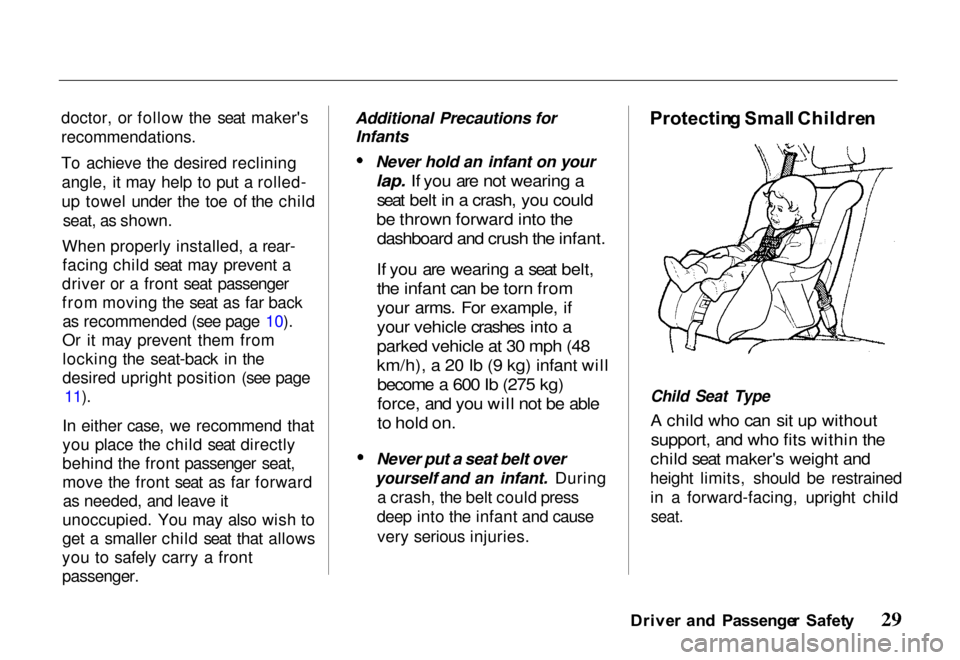
doctor, or follow the seat maker's
recommendations.
To achieve the desired reclining
angle, it may help to put a rolled-
up towel under the toe of the child seat, as shown.
When properly installed, a rear- facing child seat may prevent a
driver or a front seat passenger
from moving the seat as far back as recommended (see page 10).
Or it may prevent them from
locking the seat-back in the
desired upright position (see page
11).
In either case, we recommend that
you place the child seat directly
behind the front passenger seat,
move the front seat as far forward as needed, and leave it
unoccupied. You may also wish to
get a smaller child seat that allows
you to safely carry a front
passenger.
Additional Precautions for
Infants Never hold an infant on your
lap. If you are not wearing a
seat belt in a crash, you could
be thrown forward into the
dashboard and crush the infant.
If you are wearing a seat belt,
the infant can be torn from
your arms. For example, if
your vehicle crashes into a
parked vehicle at 30 mph (48
km/h), a 20 Ib (9 kg) infant will
become a 600 Ib (275 kg)
force, and you will not be able
to hold on.
Never put a seat belt over
yourself and an infant. During a crash, the belt could press
deep into the infant and cause
very serious injuries. Protectin
g Smal l Childre n
Child Seat Type
A child who can sit up without
support, and who fits within the
child seat maker's weight and
height limits, should be restrained in a forward-facing, upright child
seat.
Drive r an d Passenge r Safet y
Page 33 of 267
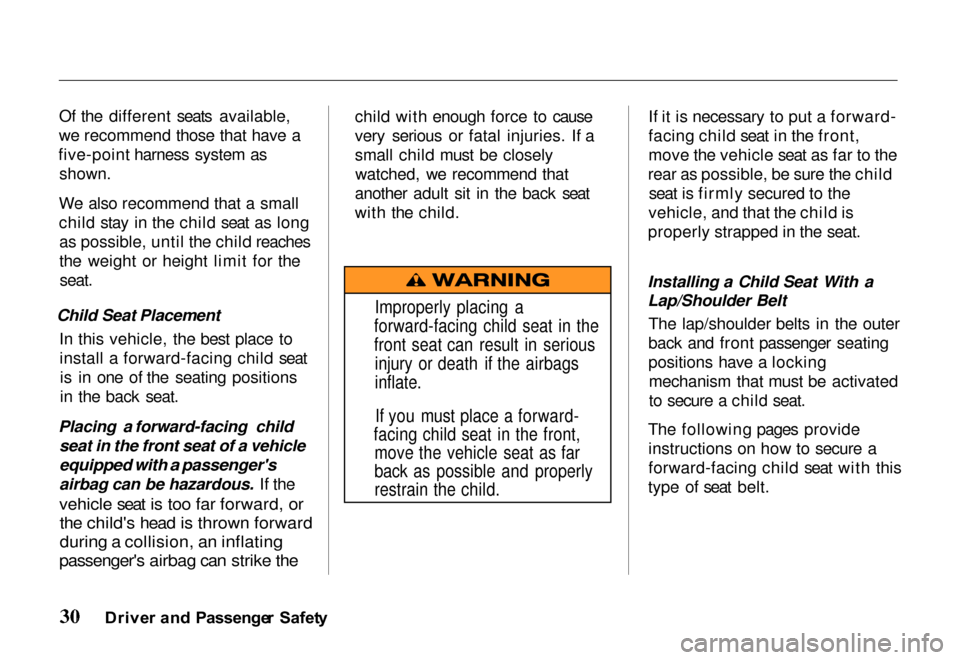
Of the different seats available,
we recommend those that have a
five-point harness system as
shown.
We also recommend that a small
child stay in the child seat as long as possible, until the child reaches
the weight or height limit for the
seat.
Child Seat Placement In this vehicle, the best place toinstall a forward-facing child seatis in one of the seating positions
in the back seat.
Placing a forward-facing child seat in the front seat of a vehicle
equipped with a passenger's
airbag can be hazardous. If the
vehicle seat is too far forward, or
the child's head is thrown forward
during a collision, an inflating
passenger's airbag can strike the
child with enough force to cause
very serious or fatal injuries. If a
small child must be closely
watched, we recommend that
another adult sit in the back seat
with the child. If it is necessary to put a forward-
facing child seat in the front,
move the vehicle seat as far to the
rear as possible, be sure the child seat is firmly secured to the
vehicle, and that the child is
properly strapped in the seat.
Installing a Child Seat With a
Lap/Shoulder Belt The lap/shoulder belts in the outer
back and front passenger seating
positions have a lockingmechanism that must be activated
to secure a child seat.
The following pages provide instructions on how to secure a
forward-facing child seat with this
type of seat belt.
Drive r an d Passenge r Safet y
Improperly placing a
forward-facing child seat in the
front seat can result in serious injury or death if the airbags
inflate.
If you must place a forward-
facing child seat in the front, move the vehicle seat as far
back as possible and properly
restrain the child.
Page 36 of 267
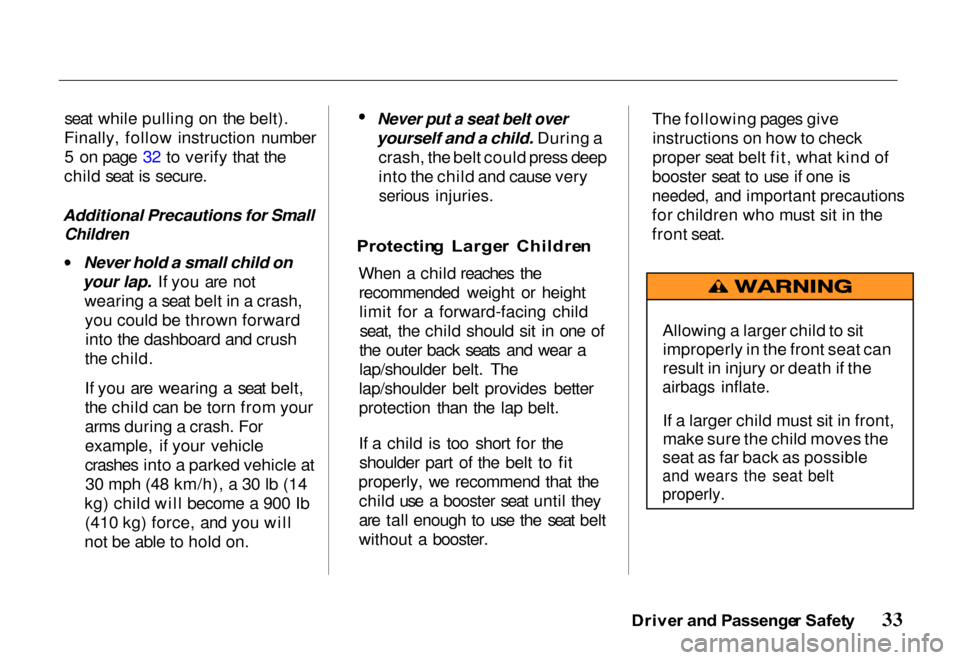
seat while pulling on the belt).
Finally, follow instruction number 5 on page 32 to verify that the
child seat is secure.
Additional Precautions for Small
Children
Never hold a small child on
your lap. If you are not wearing a seat belt in a crash,you could be thrown forwardinto the dashboard and crush
the child.
If you are wearing a seat belt,
the child can be torn from your
arms during a crash. For
example, if your vehicle
crashes into a parked vehicle at 30 mph (48 km/h), a 30 lb (14
kg) child will become a 900 Ib (410 kg) force, and you will
not be able to hold on.
Never put a seat belt over
yourself and a child. During a crash, the belt could press deep
into the child and cause very
serious injuries.
Protectin g Large r Childre n
When a child reaches the recommended weight or heightlimit for a forward-facing childseat, the child should sit in one of
the outer back seats and wear a
lap/shoulder belt. The
lap/shoulder belt provides better
protection than the lap belt.
If a child is too short for the shoulder part of the belt to fit
properly, we recommend that the child use a booster seat until they
are tall enough to use the seat belt
without a booster. The following pages give
instructions on how to check
proper seat belt fit, what kind of
booster seat to use if one is
needed, and important precautions
for children who must sit in the
front seat.
Drive r an d Passenge r Safet y
Allowing a larger child to sit
improperly in the front seat can
result in injury or death if the
airbags inflate.
If a larger child must sit in front,
make sure the child moves the
seat as far back as possible
and wears the seat belt
properly.
Page 38 of 267
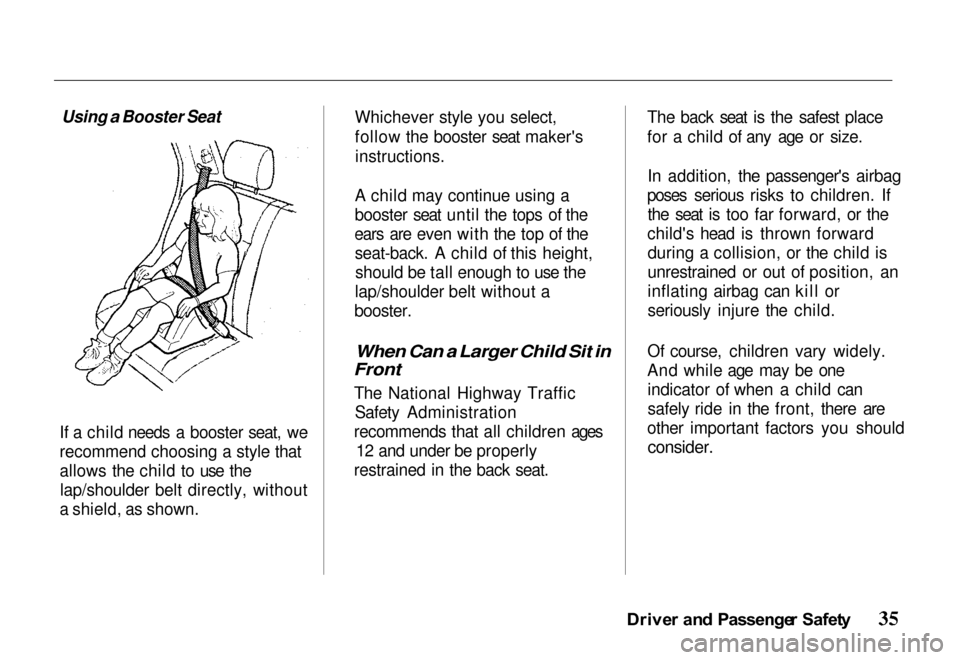
Using a Booster Seat
If a child needs a booster seat, we
recommend choosing a style that
allows the child to use the lap/shoulder belt directly, without
a shield, as shown. Whichever style you select,
follow the booster seat maker's
instructions.
A child may continue using a
booster seat until the tops of the
ears are even with the top of the seat-back. A child of this height,should be tall enough to use the
lap/shoulder belt without a
booster.
When Can a Larger Child Sit in
Front
The National Highway Traffic Safety Administration
recommends that all children ages 12 and under be properly
restrained in the back seat. The back seat is the safest place
for a child of any age or size.
In addition, the passenger's airbag
poses serious risks to children. If the seat is too far forward, or the
child's head is thrown forward during a collision, or the child is
unrestrained or out of position, an
inflating airbag can kill or
seriously injure the child.
Of course, children vary widely.
And while age may be one indicator of when a child can
safely ride in the front, there are
other important factors you should
consider.
Drive r an d Passenge r Safet y
Page 114 of 267
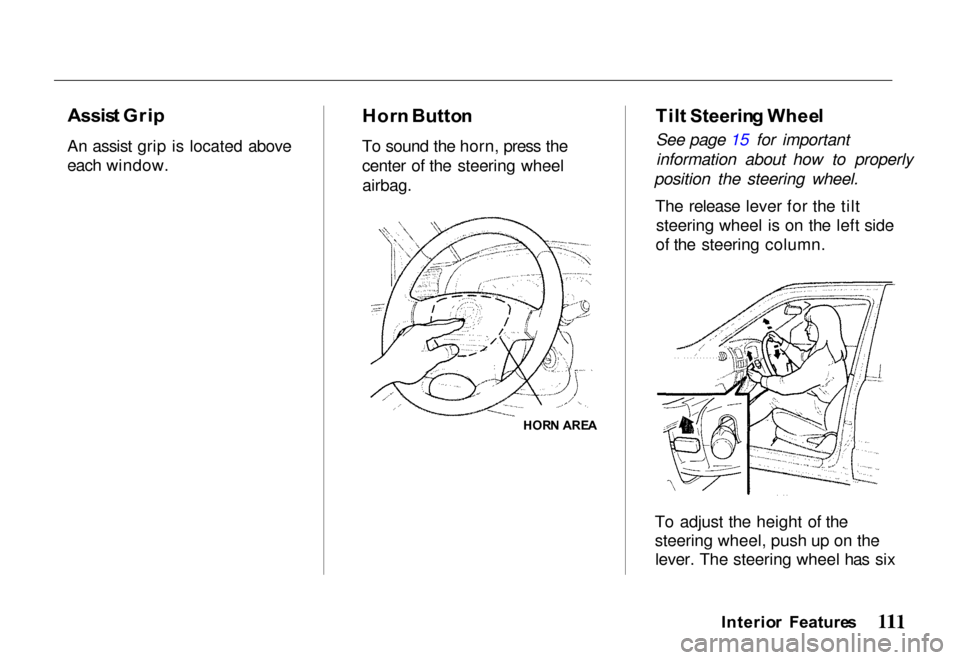
Assis
t Gri p
An assist grip is located above
each window. Hor
n Butto n
To sound the horn, press the
center of the steering wheel
airbag.
Til
t Steerin g Whee l
See page 15 for important information about how to properly
position the steering wheel.
The release lever for the tiltsteering wheel is on the left side
of the steering column.
To adjust the height of the
steering wheel, push up on the lever. The steering wheel has six
Interior Feature s
HOR
N ARE A
Page 161 of 267
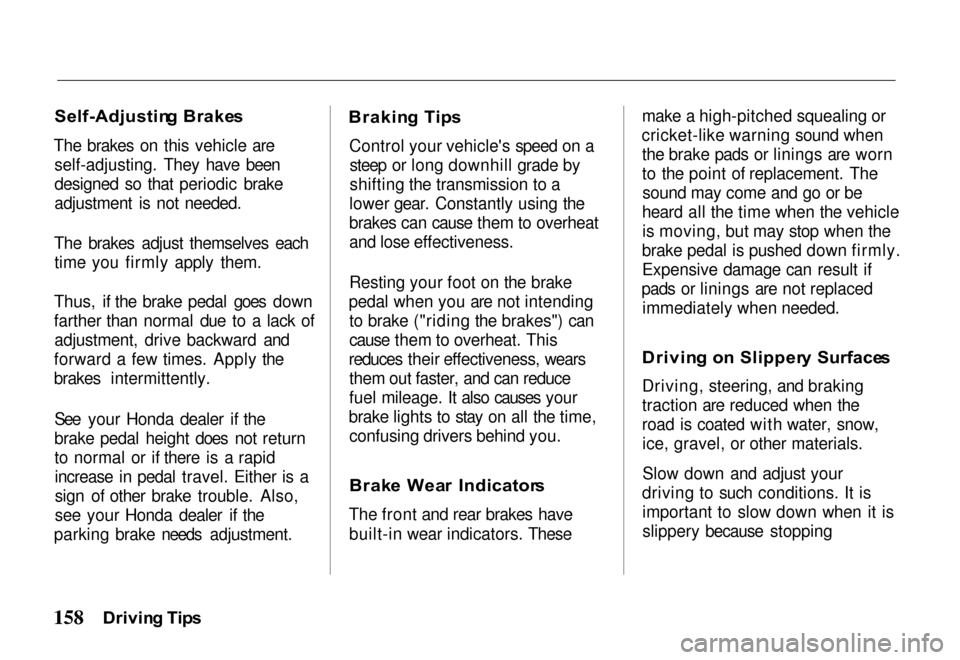
Self-Adjustin
g Brake s
The brakes on this vehicle are self-adjusting. They have been
designed so that periodic brake
adjustment is not needed.
The brakes adjust themselves each time you firmly apply them.
Thus, if the brake pedal goes down
farther than normal due to a lack of adjustment, drive backward and
forward a few times. Apply the
brakes intermittently.
See your Honda dealer if the
brake pedal height does not return
to normal or if there is a rapidincrease in pedal travel. Either is a
sign of other brake trouble. Also,
see your Honda dealer if the
parking brake needs adjustment.
Brakin
g Tip s
Control your vehicle's speed on a steep or long downhill grade by
shifting the transmission to a
lower gear. Constantly using the
brakes can cause them to overheat
and lose effectiveness.
Resting your foot on the brake
pedal when you are not intending to brake ("riding the brakes") can
cause them to overheat. This
reduces their effectiveness, wears them out faster, and can reduce
fuel mileage. It also causes your
brake lights to stay on all the time, confusing drivers behind you.
Brak e Wea r Indicator s
The front and rear brakes have built-in wear indicators. These make a high-pitched squealing or
cricket-like warning sound when the brake pads or linings are worn
to the point of replacement. Thesound may come and go or be
heard all the time when the vehicle is moving, but may stop when the
brake pedal is pushed down firmly.
Expensive damage can result if
pads or linings are not replaced immediately when needed.
Drivin g o n Slipper y Surface s
Driving, steering, and braking
traction are reduced when the
road is coated with water, snow, ice, gravel, or other materials.
Slow down and adjust your
driving to such conditions. It is important to slow down when it is
slippery because stopping
Drivin g Tip s